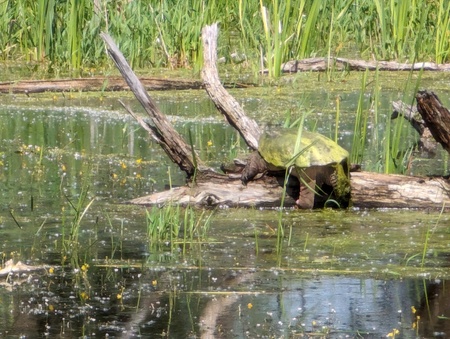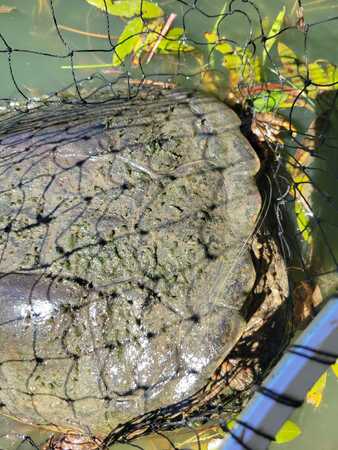
A Snappy Rescue
Snapping turtles, I think we can all agree, have an image problem. With half their name devoted to their distinctive biting technique, they’ve got to go the extra mile to show folks that, deep down, they’re really no different from the next Chelonian.
But does that ever happen? Of course not. Even though snappers spend the majority of their considerable lifespan—30 to 40 years or more—quietly prodding about the depths of our local ponds and streams, they only seem to catch people’s attention when they come up on land. Away from their aquatic environment and no longer able to swim, they’re especially vulnerable and therefore defensive. Their long necks and strong jaws are formidable features that most people run away from rather than toward.
But then there’s Amber. 
An animal trainer by profession, my friend Amber Walker has devoted much of her life to improving the lives of a wide range of mammals, birds, reptiles—you name it! She’s bottle-fed orphaned sea otter pups, swam with beluga calves, and kissed a walrus on the nose.
All this is to say, Amber is down to help any animal in need, even when that animal is a snapping turtle.
The other day, the kids who fish in the pond near Amber’s Batavia neighborhood noticed a snapping turtle swimming around a small area. No big deal, right? Except the next day, the snapper was still in the same spot and starting to struggle.
That’s when Amber got a text.
In a flash, she was on the scene with just about everything she’d need to execute a proper snapping turtle rescue: hip waders, a large landing net, and a pair of scissors. Oh, and her husband Dan. As a seasoned professional, Amber knew that no one should ever attempt a water rescue alone. Plus, Dan was able to capture the whole process on video.
The waders, it turned out, were a couple of feet shorter than the water was deep, so Amber was quickly immersed. “Don’t let anyone tell you that water isn’t cold, even in the summer,” she noted.
After making it out to the turtle, the problem became obvious: Snappy’s back leg was caught in fishing line. Looped and knotted, and anchored by something—perhaps a log?—the line held the turtle fast, with just enough length to reach the surface for occasional gasps of air.
Standing in five feet of water, Amber reached forward and netted Snappy so s/he wouldn’t be able to, well, snap, and quickly snipped through the line with the scissors. But the rescue wasn’t over yet. A considerable amount of line still entangled the turtle, a beast the size of a large serving dish.
I suppose now is as good a time as any to mention that almost exactly nine months ago, Amber was at this same pond grappling with an animal in the same predicament. On that day—Christmas Eve—a great horned owl had gotten tangled in fishing line left over from a bad cast into a tree. As with the turtle, Amber waded out to get the bird, which was dangling from the tree in the water, cut him down, and got him boxed up and sent off to the fine folks at KARE (Kane Area Rehabilitation and Education for Wildlife). After a few weeks of rest and rehab, the owl was returned to the neighborhood, ready to pick up where it left off, minus the fishing line.
As for the turtle, Amber used the old trick of rolling up a towel and placing it across the turtle’s carapace, or back. That way, when s/he tried to snap, those strong jaws would clamp down on terry cloth rather than on Amber or Dan.
Successfully freed from the line that had ensnared it, Snappy shoved off from the shoreline and swam away to recuperate from the ordeal. Amber and Dan were left with soaking-wet waders, a towel that needed washing, and a net with a new hole the size of a snapping turtle’s beak. And, most importantly, a message to spread.
“Unattended fishing line is so dangerous,” Amber says. “Fishing is a great sport, for sure, but please, clean up after your day on the water!”
Today, Snappy is happy, thanks to Amber and Dan. But other animals aren’t so lucky. If you come across discarded fishing line, do wildlife a favor: pick it up and properly discard it. I take what I find home to protect those animals that rummage through outdoor trash cans, but you can also just cut it into small pieces before throwing it away.
Recycling opportunities exist, too, though not curbside. Major retailers like Bass Pro Shops and Cabela’s have fishing line recycling bins, and some bait shops do too. Lots more info is available online!
Next week: Another animal finds itself in a pickle due to human activities.
Pam Otto is the outreach ambassador for the St. Charles Park District. She can be reached at potto@stcparks.org.

